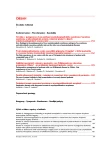-
Medical journals
- Career
První zkušenosti jednoho centra s použitím přípravku Octaplas® v léčbě pacientky s vrozenou formou trombotické trombocytopenické purpury
Authors: Z. Čermáková 1; Š. Blahutová 2; M. Kořístka 2; R. Hrdličková 2
Authors‘ workplace: Lékařská fakulta Ostravské univerzity 1; Krevní centrum Fakultní nemocnice Ostrava 2
Published in: Transfuze Hematol. dnes,18, 2012, No. 4, p. 162-164.
Category: Comprehensive Reports, Original Papers, Case Reports
Overview
Congenital form of TTP (Upshaw-Schulman syndrome) is a severe, life-threatening disease in which plasma remains the first-choice treatment. Patients are dependent on regular therapeutic plasma exchange or plasma infusion. A plasma volume of 1-1.5 is usually substituted by donors’ quarantine plasma. In these patients, secondary mild/severe side effects (allergic reactions, transfusion-induced acute lung injury) are very often observed. The authors comment on their first experience with the use of Octaplas® (Octapharma, Vienna, Austria).
Key words:
thrombotic thrombocytopenic purpura, Octaplas, therapeutical plasma exchange
Sources
1. Zheng LX, Kaufman RM, Goodnough LT, Sadler JE. Effect of plasma exchange on plasma ADAMTS13 metalloprotease activity, inhibitory level, and clinical outcome in patients with idiopathic and nonidiopathic thrombotic thrombocytopenic purpura. Blood 2004; 11 : 4043-4049.
2. Kremer-Hovinga JA, Meyer S. Current management of thrombotic thrombocytopenic purpura. Curr Opin Hematol 2008; 15 : 445-450.
3. Vesely SK, George JN, Lämmle B, Studt JD, Alberio L, El-Harake MA, Raskob GE. ADAMTS13 activity in thrombotic thrombocytopenic purpura-hemolytic uremic syndrome: relation to presenting features and clinical outcomes in a prospective cohort of 142 patients. Blood 2003; 102 : 60-68.
4. Howard MA, Williams LA, Terrell D, Duvall D, Vesely SK, George JN. Complications of plasma exchange in patients treated for clinically suspected thrombotic thrombocytopenic purpura-hemolytic uremic syndrome. Transfusion 2006; 1 : 154-155.
5. Rizvi MA, Vesely SK, George JN, Chandler L, Duvall D, Smith JW, Gilcher RO. Complications of plasma exchange in 71 consecutive patients treated for clinically suspected thrombotic thrombocytopenic purpura-hemolytic-uremic syndrome. Transfusion 2000; 40 : 896-901.
6. Kannicht C, Römisch J, Svae TE. Normal levels of ADAMTS13 and factor H are present in the pharmaceutically licenced plasma for transfusion (Octaplas®) and in the universally applicable plasma (Uniplas) in development. Vox Sang 2007; 92 : 206-212.
7. Doyle S, O’Brien P, Murény K, Fleming C, O’Donnell J. Coagulation factor content of solvent/detergent plasma compared with fresh frozen plasma. Blood Coag and Fibrinolysis 2003; 14 : 283-287.
8. Yarranton H, Lawrie AS, Purdy G, et al. Comparison of von Willebrand factor antigen, von Willebrand factor-cleaving protease and protein S in blood components used for treatment of thrombotic thrombocytopenic purpura. Transfus Med 2004; 14 : 39-44.
9. Beck KH, Mortelmans Y, Kretschmer V, Höltermann W, Lukasewitz P. Comparison of solvent/detergent-inactivated plasma and fresh frozen plasma under routine clinical conditions. Infus Ther Transfus Med 2000; 27 : 144-148.
10. Yarranton H, Cohen H, Pavord SR, Benjamin S, Hagger D, Machin SJ. Venous thromboembolism associated with the management of acute thrombotic thrombocytopenic purpura. Br J Haematol 2003; 121 : 778-785.
11. Mintz PD, Neff A, MacKenzie M, et al. Therapeutic plasma exchange (TPE) for thrombotic thrombocytopenic purpura (TTP) using plasma prepared with photochemical treatment (INTERCEPT Plasma). ASH Annual Meeting Abstracts 2004; 104 : 838.
12. Hellstern P. Fresh-frozen plasma, pathogen – reduced single-donor plasma or bio-pharmaceutical plasma? Transf and Aph Sci 2008; 39 : 69-74.
13. Pereira A. Efficacy of different plasma sources in treatment of thrombotic thrombocytopenic purpura. Vox Sang 2009; 4 : 111-117. ISBT Science Series (2009).
14. Howard MA, Williams LA, Terrell D, et al. Complications of plasma exchange in patients treated for clinically suspected thrombotic thrombocytopenic purpura-hemolytic uremic syndrome. Transfusion 2006; 1 : 154-155.
15. Čermáková Z, Hrdličková R, Šuláková T, Kořístka M, Kovářová P, Hrachovinová I. Thrombotic thrombocytopenic purpura: incidence of congenital form of disease in North Moravia (Region Moravia-Silesia). Prague Med Rep 2009; 110 : 239-244.
16. Čermáková Z, Kořístka M, Kořístková B, et al. Možnosti léčby plazmou u pacientů s hereditární formou trombotické trombocytopenické purpury. Čas Lék Čes 2009; 10 : 493-496.
17. Sinnott P, Bodger S, Gupta A, Brophyt M. Presence of HLA antibodies in single-donor-derived fresh frozen plasma compared with pooled, solvent detergent-treated plasma (Octaplas). Eur J Immunogenet 2004; 3 : 271-274.
18. Dachs U, Kauschat D, Bein G. White blood cell-reactive antibodies are undetectable in solvent/detergent plasma. Transfusion 2005; 45 : 1628-1631.
19. Heiden M, Paul Erlich Institute. Severe Transfusion Reaction. Pathogen Inactivation Consensus Conference; Toronto 29th March 2007.
20. De Vries RR., Faber JC., Strengers PF. Haemovigilance: an effective tool for improving transfusion practice. Vox Sang 2011; 100 : 60-67.
21. Scully M, Longair I, Flynn M, Berryman J and Machin SJ. Cryosupernatant and solvent detergent fresh-frozen plasma (Octaplas®) usage at a single centre in acute thrombotic thrombocytopenic purpura. Vox Sang 2007; 93 : 154-158.
Labels
Haematology Internal medicine Clinical oncology
Article was published inTransfusion and Haematology Today

2012 Issue 4-
All articles in this issue
- New findings in the pathogenesis of two myelodysplastic syndrome subtypes: 5q- syndrome and sideroblastic anaemia, partially relevant for other onco-haematological diseases
- První zkušenosti jednoho centra s použitím přípravku Octaplas® v léčbě pacientky s vrozenou formou trombotické trombocytopenické purpury
- Zajištění operačních výkonů u pacientů s von Willebrandovou chorobou preparátem Wilate® – první klinické zkušenosti jednoho centra v ČR
- The use of natural colloids in fluid resuscitation of severely burned patients
- Supportive therapy with megestrol acetate in myeloproliferative neoplasms
- Transfusion and Haematology Today
- Journal archive
- Current issue
- Online only
- About the journal
Most read in this issue- První zkušenosti jednoho centra s použitím přípravku Octaplas® v léčbě pacientky s vrozenou formou trombotické trombocytopenické purpury
- Zajištění operačních výkonů u pacientů s von Willebrandovou chorobou preparátem Wilate® – první klinické zkušenosti jednoho centra v ČR
- Supportive therapy with megestrol acetate in myeloproliferative neoplasms
- The use of natural colloids in fluid resuscitation of severely burned patients
Login#ADS_BOTTOM_SCRIPTS#Forgotten passwordEnter the email address that you registered with. We will send you instructions on how to set a new password.
- Career

